Welding indoors can pose serious risks due to limited ventilation and exposure to harmful fumes. These hazards create health and safety concerns for both professional and DIY welders. To address these challenges, indoor welding techniques must prioritize safety through proper ventilation, fume extraction, and personal protective equipment (PPE). Also, choosing the right welding machine and ensuring a well-prepared workspace can minimize risks. By following specific safety guidelines, welders can work efficiently and safely indoors.
What is Indoor Welding
Indoor welding refers to fusing metals within enclosed spaces such as workshops, garages, or industrial facilities. It typically involves controlled environments where welders must take extra precautions due to limited ventilation and space. Common welding techniques like MIG, TIG, and stick welding are frequently performed indoors for metal fabrication and repairs.
The nature of indoor welding requires special considerations, such as proper air circulation to avoid fume buildup and suitable safety measures to prevent fire hazards. By understanding the specific challenges of working indoors, welders can ensure their work’s safety and quality, using the right techniques and equipment for these enclosed spaces.
Key Considerations for Indoor Welding
Ventilation
Proper ventilation is crucial in indoor welding to prevent the buildup of hazardous fumes and gases. Welding indoors produces fumes containing harmful substances like metal particles and gases, which can pose significant health risks. To maintain safe air quality, welders must ensure adequate ventilation through mechanical systems like fume extractors or natural airflow. Effective ventilation helps reduce exposure to harmful particles and ensures a healthier working environment.
Fire Safety and Hazards
Welding indoors carries a higher risk of fire hazards due to the confined environment and the presence of flammable materials. Sparks from welding can easily ignite nearby objects, making fire prevention measures essential. Keep flammable items away from the welding area and have fire extinguishers readily available. Installing fire-resistant barriers or curtains around the workstation can reduce the risk of accidental fires.
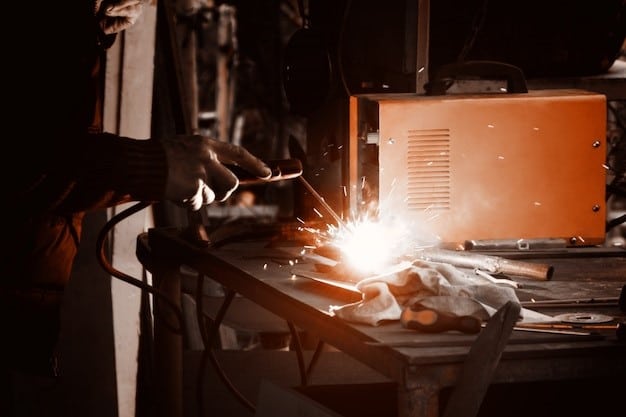
Lighting and Workstation Setup
Good lighting is essential for accuracy and safety in indoor welding. Poor lighting can lead to errors in welding joints and increase the risk of accidents. Ensure the workspace is well-lit, using overhead and task lights to illuminate the welding area directly. The workstation should also be organized to prevent clutter, which can become a safety hazard during welding. Keeping tools and materials within easy reach helps maintain efficiency and reduces the chances of injury.
Electrical Infrastructure
A stable electrical infrastructure is vital for indoor welding since most machines require substantial power. Ensure that the workspace is equipped with appropriate electrical outlets and circuits capable of handling the power demands of welding equipment. Overloaded circuits can lead to power outages or, worse, electrical fires. Regularly inspecting electrical systems and maintaining proper grounding are key to preventing accidents related to electrical faults.
Types of Welding Techniques Suitable for Indoor Use
MIG Welding Indoors
MIG (Metal Inert Gas) welding is one of the most popular techniques for indoor welding due to its ease of use and efficiency. It involves feeding a continuous wire electrode through a welding gun while a shielding gas protects the weld from contamination. A MIG welder is a good choice for beginners and professionals alike because it is straightforward and can be used on various metals such as steel and aluminum. Indoors, it is particularly beneficial since it produces fewer sparks than other methods, making it a safer option for confined spaces. However, proper ventilation is still required, as the shielding gas can displace oxygen, posing health risks.
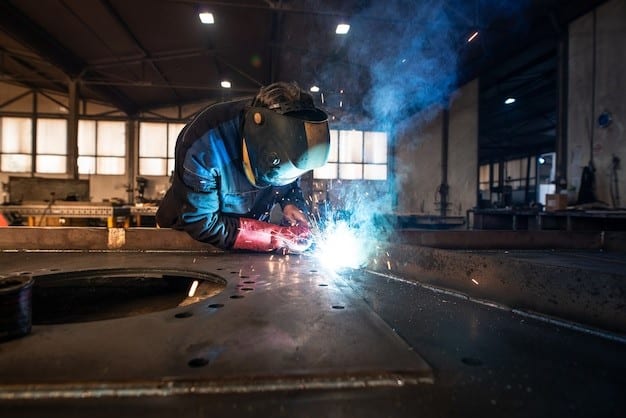
TIG Welding Indoors
TIG (Tungsten Inert Gas) welding is known for its precision and control, making it a great choice for delicate indoor projects. Unlike MIG welding, TIG welding uses non-consumable tungsten welding electrodes and requires the TIG welder to feed filler metal manually. This technique is excellent for welding thin materials and produces high-quality, clean welds without much spatter. TIG welding is often preferred for applications that require fine detailing, such as automotive or aerospace repairs. The absence of slag and minimal smoke makes it a cleaner method for indoor environments. However, it requires more skill and concentration, making it less ideal for beginners.
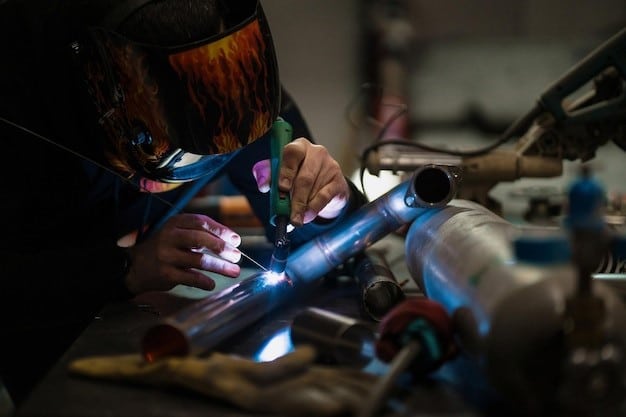
Stick Welding Indoors
Stick welding, or Shielded Metal Arc Welding (SMAW), is a versatile technique for welding thicker materials. It is one of the most robust methods. A stick welder is suitable for indoor use in workshops or garages. Stick welding is beneficial because it does not require an external shielding gas, as the electrode used has a flux coating that produces a protective shield when burned. However, stick welding generates more fumes and spatter than other methods, which can be problematic indoors if ventilation is inadequate. It’s an effective method for structural projects and repairs but requires strict safety measures due to the high levels of smoke and sparks.
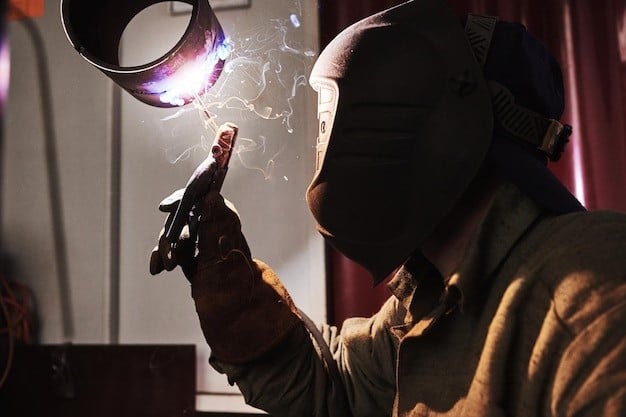
Laser Welding Indoors
Laser welding is a highly advanced technique suitable for precise and clean welds, especially indoors. This method fuses materials using a focused laser beam, creating minimal heat-affected zones. Laser welding is ideal for electronics, automotive, and medical device manufacturing industries, where precision is crucial. One of the main advantages of laser welding indoors is that it produces minimal spatter, fumes, and noise, making it one of the safest options for confined spaces. However, laser welding requires specialized equipment and expertise, making it more costly and less accessible to general welding tasks.
Choosing the Right Indoor Welding Machine
Selecting the right welding machine for indoor use is essential to ensure efficiency and safety. To suit your specific welding needs, various factors must be considered, such as power requirements, size, welding machine suppliers, and noise levels.
Power Requirements
- Voltage and Amperage: Indoor welding machines must match the power output of the workspace. Machines typically require a stable electrical supply of either 120V or 240V.
- Duty Cycle: Ensure the machine has a sufficient cycle to avoid overheating, especially for long welding sessions.
- Current Type: Consider whether the machine supports AC and DC currents, as different welding techniques require specific types.
Size and Portability
- Compact Design: Indoor spaces often have limited room, so a compact welding machine is ideal.
- Weight Consideration: A lighter machine allows for easier maneuverability within the workspace.
- Wheels and Handles: Machines with wheels or handles make transportation and setup more convenient in enclosed areas.
Welding Machine Suppliers
- Reputable Brands: Choose machines from well-known manufacturers that provide reliable performance and after-sales support.
- Warranty and Support: Opt for suppliers that offer warranties and customer support for maintenance and repair needs.
- Price vs. Quality: Ensure the welding machine offers the best value for your budget without compromising safety and quality.
Noise Levels
- Quiet Operation: Indoors, the noise from welding machines can be amplified, so selecting a machine with lower decibel ratings is beneficial.
- Noise Regulations: Check local noise regulations, especially if the welding workspace is near residential areas.
- Noise Reduction Features: Some machines come with noise-dampening technology, reducing the impact on your working environment.
Comparison of Welding Techniques for Indoor Use
| Welding Technique | Description | Ease of Use | Required Skill Level | Common Applications | Advantages | Disadvantages |
| MIG Welding | Metal Inert Gas welding uses a continuous wire electrode and a shielding gas. | Easy to moderate | Moderate | Metal fabrication, repairs, automotive | Easy to learn, versatile, less spatter | Requires proper ventilation due to shielding gas displacing oxygen. |
| TIG Welding | Tungsten Inert Gas welding uses a non-consumable tungsten electrode and manual filler metal feed. | Difficult | High | Precision work, thin materials, aerospace, automotive | High precision, clean welds, no slag | Requires high skill level, slower process, more expensive equipment. |
| Stick Welding | Shielded Metal Arc Welding uses a coated electrode that produces a protective gas shield. | Easy to moderate | Moderate | Structural projects, heavy-duty repairs | Versatile, does not need external shielding gas | Generates more fumes and spatter, less clean than MIG or TIG. |
| Laser Welding | Uses a focused laser beam to fuse materials with minimal heat-affected zones. | Advanced | High | Electronics, automotive, medical devices | High precision, minimal spatter and fumes | Expensive, requires specialized equipment and expertise. |
Indoor Welding Safety
Safety Guidelines
Indoor welding requires strict adherence to safety guidelines to prevent accidents and health hazards. Ensure the workspace is free of flammable materials and have a fire extinguisher on hand. Regularly inspect equipment for faults and always turn off machines when not in use. Maintaining a clutter-free area also reduces trip hazards and improves overall safety.
PPE (Personal Protective Equipment)
Personal protective equipment is essential in indoor welding to protect against burns, fumes, and electrical shocks. Welders should wear flame-resistant clothing, a welding helmet with proper eye protection, and heat-resistant welding gloves. Sturdy boots and hearing protection may also be necessary, depending on the type of welding performed.
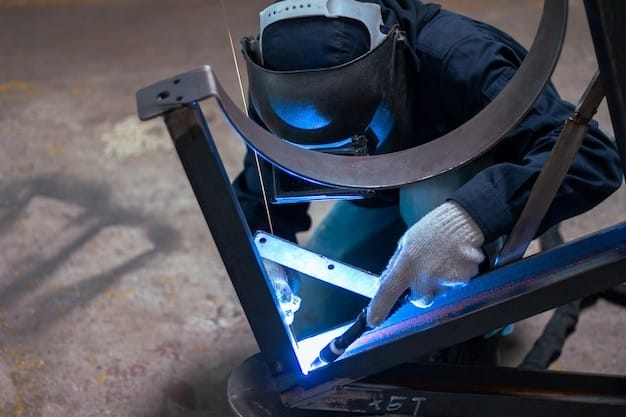
Air Quality
Maintaining good air quality in indoor welding spaces is vital, as welding processes release harmful gases and particulates. Without proper ventilation, these contaminants can lead to respiratory issues over time. To minimize exposure to harmful substances, it’s important to ensure continuous airflow in the workspace.
Fume Extraction
Fume extraction systems are necessary to capture and remove welding fumes at the source. Portable or stationary fume extractors help remove toxic particles, improving indoor air quality. These systems reduce the welder’s exposure to hazardous fumes and ensure a safer working environment.
Final Thoughts
Indoor welding requires careful planning and strict adherence to safety protocols to ensure a productive and hazard-free environment. By understanding the various welding techniques, choosing the right equipment, and following safety measures like proper ventilation and personal protective equipment, welders can work efficiently while minimizing risks. Selecting the appropriate welding machine and maintaining good air quality is equally important for creating a safe and effective workspace. Whether for hobbyists or professionals, implementing these strategies will lead to better welding results and a safer indoor working experience.
FAQs
Is it safe to weld indoors?
Yes, indoor welding can be done safely with proper precautions like good ventilation, fire safety measures, and protective equipment.
What types of welding are suitable for indoor use?
MIG, TIG, stick, and laser welding are suitable for indoor use, provided proper safety measures are in place.
What ventilation is needed for indoor welding?
Ventilation is essential to remove fumes. Use natural airflow or fume extraction systems for proper air quality.
What personal protective equipment (PPE) is needed for indoor welding?
Wear flame-resistant clothing, helmets, gloves, and boots. For fume-heavy tasks, additional protection, such as masks, may be required.



